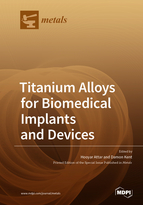Titanium Alloys for Biomedical Implants and Devices
A special issue of Metals (ISSN 2075-4701). This special issue belongs to the section "Biobased and Biodegradable Metals".
Deadline for manuscript submissions: closed (30 June 2019) | Viewed by 46281
Special Issue Editors
Interests: metal matrix composites; additive manufacturing; tribology; powder metallurgy
Special Issues, Collections and Topics in MDPI journals
2. Queensland Centre for Advanced Materials Processing and Manufacturing (AMPAM), University of Queensland, Brisbane, QLD 4072, Australia
Interests: light metals; powder metallurgy; additive manufacturing; phase transformations; composites
Special Issues, Collections and Topics in MDPI journals
Special Issue Information
Dear Colleagues,
A range of materials may be used in the human body including metals, ceramics, and polymers. Among them, titanium alloys have received significant interest leading to widespread successful adoption in the biomedical field due to their unique combination of outstanding properties. Over the past decades, a large amount of research has focused on various aspects of titanium alloys leading to the design, production, and commercialization of a series of alloys specifically tailored to biomedical applications. Despite the outstanding properties afforded by current titanium alloys, there is a need to continue to enhance their performance through developing further understanding of important aspects of their processing and structure. This is necessary to enhance performance and reliability of titanium implants and devices and, consequently, improve patient health outcomes and reduce the need for painful and costly revisionary surgery. This Special Issue seeks to collect expert views and article contributions on various aspects of a wide range of titanium alloys to highlight challenges and recent advances relevant to the biomedical area. This issue is dedicated to all aspects of titanium biomedical alloys which include, but are not limited to:
- New alloy design
- Chemical, physical, and toxicological properties
- Microstructures, phase analysis, and mechanical properties
- Mechanical behavior, damage, and failure
- Simulation and modeling techniques
- Corrosion and tribology properties
- Net shape and additive manufacturing
- Surface functionalization and modification
- Biological tests
- Porous and complex hierarchical structures
This Special Issue looks forward to receiving submissions in any form, including review articles, regular research articles, and short communications. Both experimental and theoretical studies are of interest.
Kind regards,
Dr. Hooyar Attar
Dr. Damon Kent
Guest Editors
Manuscript Submission Information
Manuscripts should be submitted online at www.mdpi.com by registering and logging in to this website. Once you are registered, click here to go to the submission form. Manuscripts can be submitted until the deadline. All submissions that pass pre-check are peer-reviewed. Accepted papers will be published continuously in the journal (as soon as accepted) and will be listed together on the special issue website. Research articles, review articles as well as short communications are invited. For planned papers, a title and short abstract (about 100 words) can be sent to the Editorial Office for announcement on this website.
Submitted manuscripts should not have been published previously, nor be under consideration for publication elsewhere (except conference proceedings papers). All manuscripts are thoroughly refereed through a single-blind peer-review process. A guide for authors and other relevant information for submission of manuscripts is available on the Instructions for Authors page. Metals is an international peer-reviewed open access monthly journal published by MDPI.
Please visit the Instructions for Authors page before submitting a manuscript. The Article Processing Charge (APC) for publication in this open access journal is 2600 CHF (Swiss Francs). Submitted papers should be well formatted and use good English. Authors may use MDPI's English editing service prior to publication or during author revisions.
Keywords
- Titanium alloys
- Microstructures
- Mechanical characterization
- Modeling
- Additive manufacturing
- Surface treatment
- Corrosion
- Tribology
- Biology







